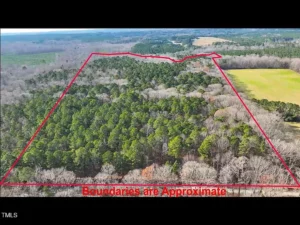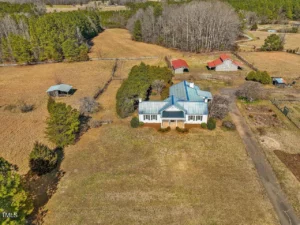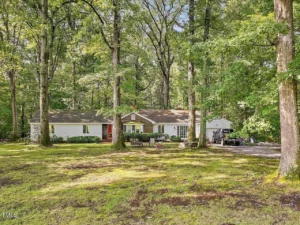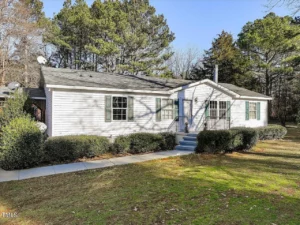Land Sales Agent Eric Andrews discusses graveyards and cemeteries and land sales in this video.
Speaker 1: You got any recent, interesting real estate stories?
Speaker 2: Well, yeah. So we just sold a house in the Eastern part of the county and on the survey there was no mention of a graveyard, but on the PERP permit, a previous agent had written ‘cemetery’ on the PERP permit. This is a nine and a half acre piece of property so a pretty fairly large piece of property.
Speaker 1: So this was found when the buyer was doing their due diligence?
Speaker 2: This was revealed by us as part of our company policy. We have PERP permits on our documents. So that’s something that we do differently than other firms so if we say it’s a four-bedroom house, you have the PERP permit. We want people to know the schematic.
Speaker 1: To the seller.
Speaker 2: We represent the seller and so we have this information on the airways, it’s on the internet, it’s easily accessible for a buyer or for the other agent. We want to make this as smooth as possible. And so, the agent asked the buyer’s agent asked and said, “Yeah Eric, our people want to put in pasture, do a horse property, convert some of this wooden land, but they’re concerned about the cemetery on the PERP permit. Do you think you could have the seller locate that?” I’m like, “Sure, okay.” And because the previous agent, the developer agent, another fellow land guy in the county, really, really good guy, I was like, “Well, let me call him up first.”
And so, I call him up and he’s like, I mean, this guy’s going back on 15 years memory and he’s like, “Yeah, I vaguely remember that one. Yes, we did disclose it on the PERP permit.” He’s like, “I think it was somewhere around six to eight grave sites.” And I was like, ” Oh, well that’s on a nine and a half acre piece.” We’re talking 400, 500,000 square feet of property. “10, 30 square feet’s not going to make a big difference. I’m sure you can make pasture around it.” So I tell my seller, my seller’s like, “Sure, no problem. I know exactly where it is. I’ll go mark it off and that way the buyers can see it.” And the seller calls up and he is like, “Eric, I think I found it, but I’m not sure.” And I was like, “Well, this is important, I want to make sure that you found the right thing,” and he based it off the schematic of that PERP permit.
Sure enough, I go out there, he’s an engineer, did a lovely job. I mean, he had poles with tennis balls and yellow string, and he had this little area marked out and having a land guy in Chatham county, we know what to look for. So, so wild that here we are going through COVID-19, the main reason why I have grave sites on rural property is because of the Spanish flu. So you’ll see all these beautifully marked cemeteries where these nice headstones and they’ll have carvings in them from the 1800s and sometimes the 1900s and they’re fairly nice stones because that’s what people did, they buried themselves on their farms. And then 1914 to 1922, there’s like this gap when the Spanish flu came and it’s just little rocks and indentations in the ground.
So they had so many deaths with the Spanish flu that some of them are not as well-marked. So anyways, I go out there, he’s got his four tennis balls and his poles out there and I look down and I’m like, “Hey, what do you got?” And he is like, “See? Right there,” and it’s just two rocks laying down on the ground like each the size of a football and I’m like, “yeah, that’s not it.” He’s like, “Well, how do you know what you’re looking for?” It’s that old joke, I don’t know what it is, but I know it when I see it. And I said, “Well, first of all, we’re looking for rocks that are standing up that just couldn’t possibly have happened in nature. And then, you’re looking for a two and a half wide dent, four to seven feet long.
Sometimes there’s a foot, not only is there a headstone, but sometimes there’s a foot stone as well. I said, “It’s usually on a Hilltop or whatever.” So we walk this entire nine and a half acres and I’m going from hilltop to hilltop to hilltop and he’s like, “Here’s a rock,” and I’m like, “Yeah, it’s just a rock.” There’s a small stream going through the property, I’m like, “Yeah, they never buried anybody on a stream, it was always on a hilltop.” And so we walk the entire property and everything and we get back and I go, “Yeah, like that, that’s what we’re looking for.” And sure enough, there’s a rock that’s standing up straight like that. And I was like, “That actually might be a grave and everything.” And then I start looking around and sure enough, there’s that two and a half foot wide dent, six feet long.
We get to looking around and everything, there’s trees coming up and everything and instead of six to eight, there’s like 20 to 25 and I’m guessing it was mid-1800s. They’ve definitely been there for a long, long time, I’m sure there’s not anything left. There’s certainly no coffin or bones or whatever, but still want to be respectful of the area. North Carolina has specific visitation rights for the family or whatever. There’s no way to tell that there’s a family there. So the seller’s an engineer, his daughter’s actually a math teacher and he’s like, “So what do you think the square footage is here?” And I’m like, “It’s an oval. I don’t know. I don’t remember how to do oval from high school or whatever.” And he’s like, “Oh, I know how to do oval.”
And so they mark it out and it was a little bit over a tenth of an acre, I think it was like 0.15 or whatever so like an eighth of an acre. But it was an area that we have to avoid. Didn’t know if this was going to be a concern to the buyer. The buyer came out. It really wasn’t a big issue to them or whatever. And then another time, I had a piece of land out in Silk Hope and this was the black iron fence with some six and seven foot tall headstones. That was a prominent family in the Silk Hope area and they still went out there on a regular basis and weeded it around and cleaned up and everything. And so that was 17 acres. We’re talking about New Jersey clients.
This guy was from New Jersey, 17 acres. This was a long time ago, I think the 17 acres at the time was probably worth $100,000. I priced the 17 acres for $75,000. So people would call up and say, “Why is this land so cheap?” And I’m like, “Well, it’s got a cemetery in the middle of it.” Click, and people hang up.
This guy from New Jersey calls up and he’s like, “Why is this land so cheap?” And I’m like, “It’s got a cemetery in the middle.” He’s like, “So what does that mean?” I go, “Well, you can’t ever take it down and you have to let the family visit and everything.” He’s like, “Is that it?” I’m like, “Yep!” and he’s like, “All right, I’m going to buy it.” So he buys it, he builds a house out there. I see him like a year or two late and I’m like, “Hey, how’d it go with that? You built the house.” He’s like, “Yeah, I built the house.” I said, “Are you happy out there?” He was like, “I love it out there.” And I was like, “And the cemetery? Has that been an issue?” He’s like, “Quietest neighbors I’ve ever had!”
And then, sure enough, I did another one out in Durham, in the middle of Durham and this was in a nice little subdivision and everything. They had some between them and a big power line easement. And they’re like, “What do we do about that?” And I was like, “We just disclose it.” That house sold in five days, it wasn’t a big deal at all. We do have them and then I just sold a house last month. This is real real estate for you. We’re talking grave stories. And so, I sold a house last month and there’s this giant mound in the middle of the backyard, like really big and I get a couple calls and I’m like, “I don’t know, it’s just a mound. It’s not a big deal and everything.”
And so another agent calls and says, “I really want to know what that mound is.” And I’m like, “Fine.” And so I called a seller. I’m saying New Jersey all the time, the seller’s from New Jersey, Paul from New Jersey and his brother actually lives in Pittsboro and his brother is a mailman and his brother lives across the street. And he’s like, “Yeah, I know what that is.” I’m like, “What is it?” And he’s like, “That’s where the lady’s horse died. They buried the horse in the back.” I’m like, “Ah no! They buried the horse!” So it’s this huge mound of where they buried a horse in that background. And so then I had to tell all day and the lady that bought it, she’s like, “Yeah, I’m fine with it. That’s no problem.” I mean, it was like eight acres. So it’s just an area that you avoid or grow tomatoes or something.





